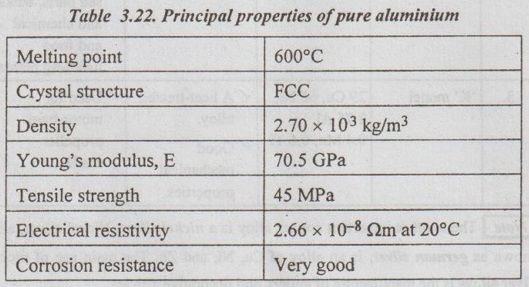Aluminium is one of the most abundant elements in the earth's crust and also the most important of the non-ferrous metals.
ALUMINIUM
Aluminium is one of the most abundant elements in the earth's crust and also the most important of the non-ferrous metals.
1. Characteristics of Aluminium
Pure aluminium is known for its outstanding characteristics. Some of its main characteristics are:
(i) Light-weight (one-third the weight of steel),
(ii) High thermal and electrical conductivity,
(iii) Excellent corrosion resistance,
(iv) Non-toxicity,
(v) Soft and ductile,
(vi) Low specific gravity,
(vii) High strength-to-weight ratio, and
(viii) High reflectivity.
Table 3.22 presents the principal properties of pure aluminium↑.

† How is aluminium extracted?
The aluminium is extracted from bauxite ores as follows:
(i) The bauxite is ground and then it is purified.
(ii) It is then dissolved in fused cryolite which is a double fluoride of aluminium and sodium, AIF3, 3 NaF.
(iii) This solution is then taken to an electric furnace and the aluminium is separated out by electrolysis.
2. Aluminium Vs Copper
Nowadays aluminium replaces the copper as an electrical con- ductor due to the following reasons:
(i) The price of the aluminium is much lower than that of copper.
(ii) The specific gravity of aluminium is only 2.7 compared to 8.9 for copper.
(iii) The electrical conductivity of EC-grade (electrical conductor) aluminium is 61% of the conductivity of standard copper, based on equal cross sections.
(iv) If equal weights of aluminium and copper conductors of a given length are compared, it is found that aluminium conducts 201% as much current as does copper.
However, an important limitation of aluminium in this regard is the difficulty of soldering or joining it. This can be overcome by chemically coating aluminium with tin, followed by plating with other metals.
The pure aluminium has a very low strength. Hence for most engineering purposes, aluminium is alloyed in order to obtain a higher strength/weight ratio.
3. Applications of Aluminium
✔ The aluminium is chiefly used for making parts of aeroplane, cooking utensils, electric wires, window frames, glazing bars, corrugated sheets, foils, posts, furniture, precision surveying instruments, surgerical instruments, etc.
✔ It is used as a reducing agent in the manufacture of steels.
✔ It is used in the manufacture of electrical conductors and paints of bo in powder form.
No comments:
Post a Comment